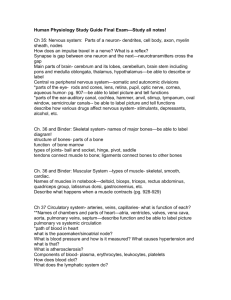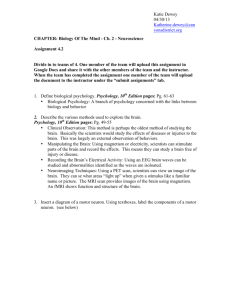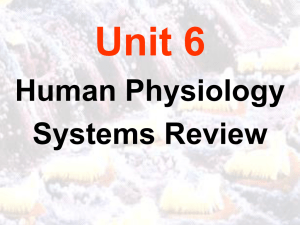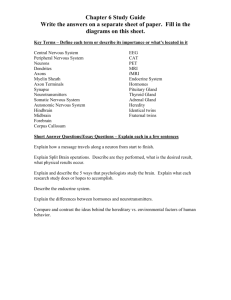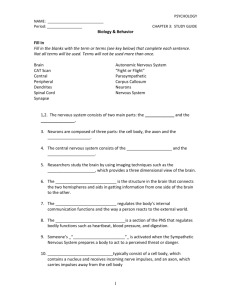Chapter 3
advertisement
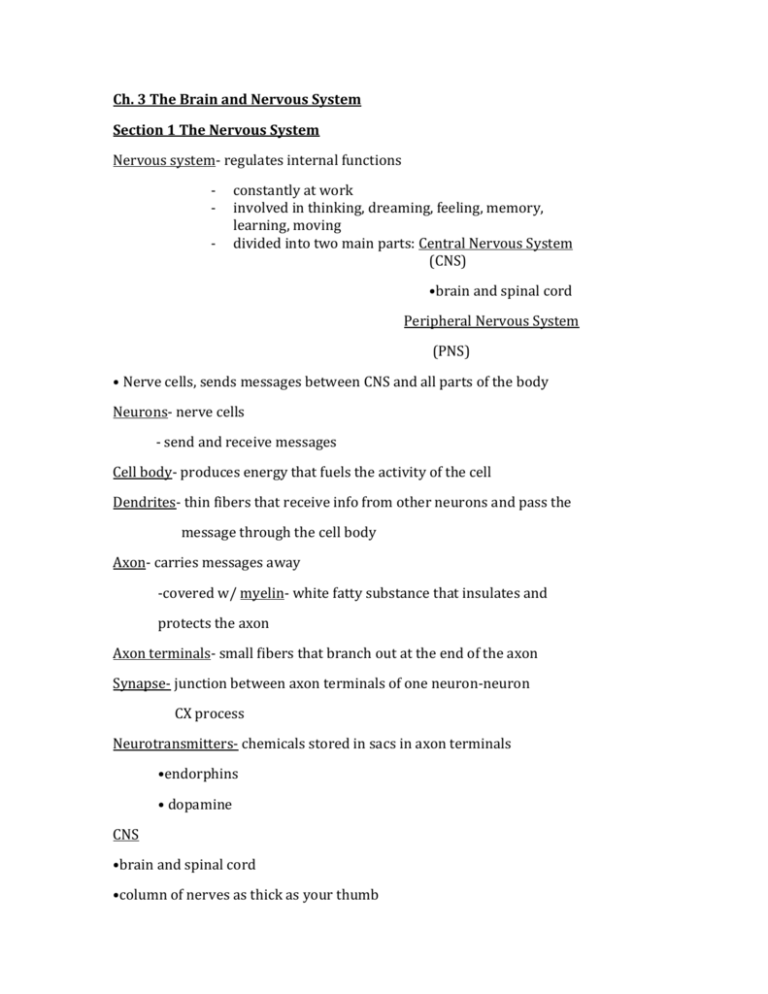
Ch. 3 The Brain and Nervous System Section 1 The Nervous System Nervous system- regulates internal functions - constantly at work involved in thinking, dreaming, feeling, memory, learning, moving divided into two main parts: Central Nervous System (CNS) •brain and spinal cord Peripheral Nervous System (PNS) • Nerve cells, sends messages between CNS and all parts of the body Neurons- nerve cells - send and receive messages Cell body- produces energy that fuels the activity of the cell Dendrites- thin fibers that receive info from other neurons and pass the message through the cell body Axon- carries messages away -covered w/ myelin- white fatty substance that insulates and protects the axon Axon terminals- small fibers that branch out at the end of the axon Synapse- junction between axon terminals of one neuron-neuron CX process Neurotransmitters- chemicals stored in sacs in axon terminals •endorphins • dopamine CNS •brain and spinal cord •column of nerves as thick as your thumb •protected by bones of the spine PNS 1. Somatic Nervous System- transmits sensory messages to CNS - activated by pain, touch, temp. changes, body position 2. Autonomic Nervous System- regulates vital functions: heart rate, breathing, digestion, blood pressure a. Sympathetic Nervous System-“flight or fight” b. Parasympathetic Nervous System- restores body to normal Section 2 The Brain: Our Control Center Brain- many parts that work together to organize movements, create thoughts, form emotions, and produce behaviors -three main parts: Hindbrain, Midbrain, Forebrain Hindbrain- lower portion of the brain involved in vital functions a. Medulla-vital functions: heart rate, breathing, blood pressure b. Pons- regulates body movement, attention, sleep, alertness c. Cerebellum-“little brain”, balance and coordination Midbrain- in middle, vision and hearing a. Reticular Activating System- sleep, attention, arousal - affected by alcohol - responds to loud noises Forebrain- in front a. Thalamus- inner chamber, relay station that transmits info b. Hypothalamus- regulates body temp., storage of nutrients, aspects of motivation and emotion Limbic System- learning, memory, emotion, hunger, sex, aggression; “Primal” Cerebrum- largest part of the brain •two sides-Hemispheres-connected by corpus callosum •left hemi. controls right side of body •right hemi. controls left side of body •right brained vs. left brained • each hemi. divided into 4 parts-Lobes Lobes: 1. 2. 3. 4. Frontal lobe-behind forehead, motor cortex, higher level thinking Parietal lobe- top and rear- skin senses, warmth, cold, touch Temporal lobe-sides below ears- hearing Occipital lobe- back of head- vision Association areas- shape all info into something meaningful on which we can act 1. Wernicke’s Area- in temporal lobe, puts together sight and sound - if damaged-difficulty understanding speech 2. Broca’s area- frontal lobe, controls parts of face used for speaking - if damaged-slow speech, simple sentences Section 3 The Endocrine System Endocrine system- glands that secrete hormones into the blood stream Hormones- stimulate growth, affect behavior and emotional reactions Pituitary gland- “master gland”, growth hormones, muscle, bones, glands Thyroid gland- responsible for metabolism-regulates weight Adrenal gland- adrenaline-emergency situations, heighten your senses Reproductive systems- ovaries and testes Section 4 Heredity: Our Genetic Background Heredity- transmission of characteristics from parent to offspring What can we inherit? Genes- basic building blocks of heredity -pairs of genes that determine traits - threadlike structures-chromosomes Nature vs. Nurture Nature= what we inherit Nurture= environmental factors, culture, education, experiences Kinship studies Twin Studies- identical or fraternal
